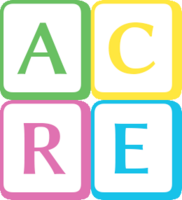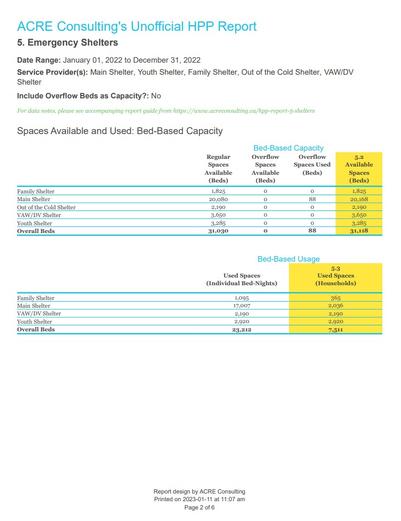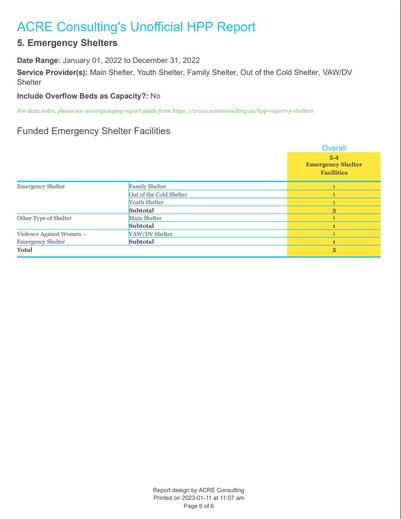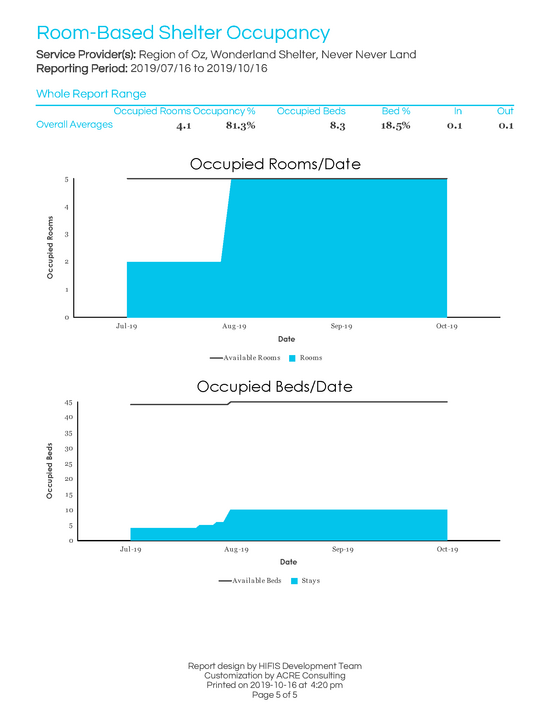ACRE Consulting's Unofficial HPP Report
5. Emergency Shelters
This report is intended to allow communities in Ontario who receive HPP funding to use HIFIS data to report out on the Emergency Shelters section of the HPP reporting requirements. Broadly, it reports on emergency shelter capacity and usage, broken down into priority population groups.
This is an unofficial report and is not endorsed by the Ontario MMAH.
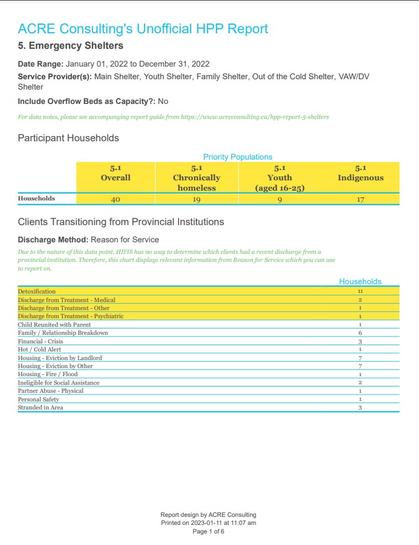


5. Emergency Shelter Usage
Communities are required to report on the emergency shelter system that's funded through HPP. Required data elements include:
- people that stayed in emergency shelter: households and priority populations
- bed-nights available
- bed-nights used
- emergency shelter facilities funded by HPP
There are a few noteworthy nuances to point out here in the requirements: Service Managers are required to count bed-nights used and available, but not in the way that you'd typically think. Each household counts as occupying one space, regardless of whether they're occupying 1 bed or 8 beds, and a "bed-night" is defined as a bed or a space/room for a single night. Typically, this means that for single shelters, you'd be counting beds and bed-nights, and for family shelters, you'd be counting rooms and room-nights.
Features of this Report
Frequently Asked Questions
- What version of HIFIS is required to run this report? This report should work for any version of HIFIS 4.0.57 or higher. There is a version for 4.0.59 and under and a different version for 4.0.60 and over.
- What happens if the report stops working? This report will be maintained into the foreseeable future. If a software update causes it to stop working, or if we find an error, we'll update the file and let you know there's a new version available, at no additional cost to you.
- How long does this report take to run? The run-time varies depending on how much data is in your database, and how long a date range and how many service providers you select when running the report. However, we have tested the report with large data volumes and it runs quickly and efficiently.
- What parameters are included in this report? Included parameters are: Service Provider(s); Start Date; End Date; Discharge Module (single-select drop-down field which includes 4 options: Reason for Service, Referred From, Housing History, Life Events); Include overflow beds as capacity? (asks if beds in HIFIS marked as Overflow beds should be counted towards your shelter system capacity).
- How do I run this report? Check out our README file.
- I have a question about the report calculations. Check out our Report Guide.
You may also like...
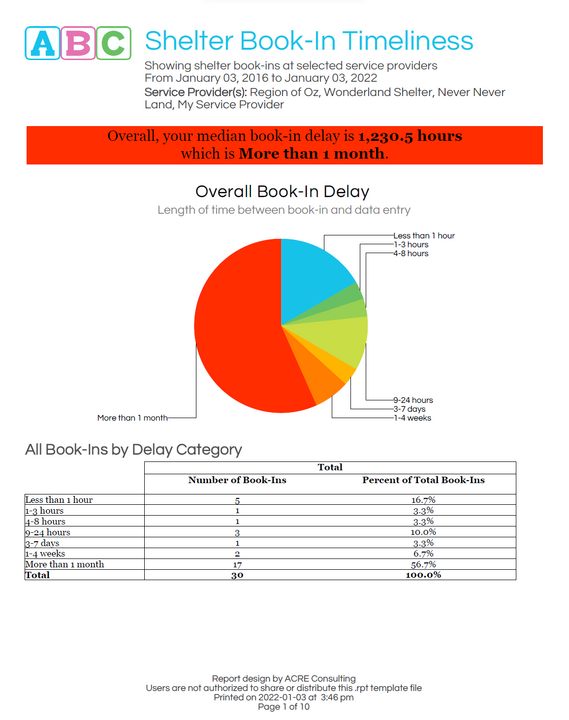
This report contains everything a community or service provider needs to conduct a data quality timeliness audit for their shelter book-ins. It measures the gap between actual book-in time and data entry time.
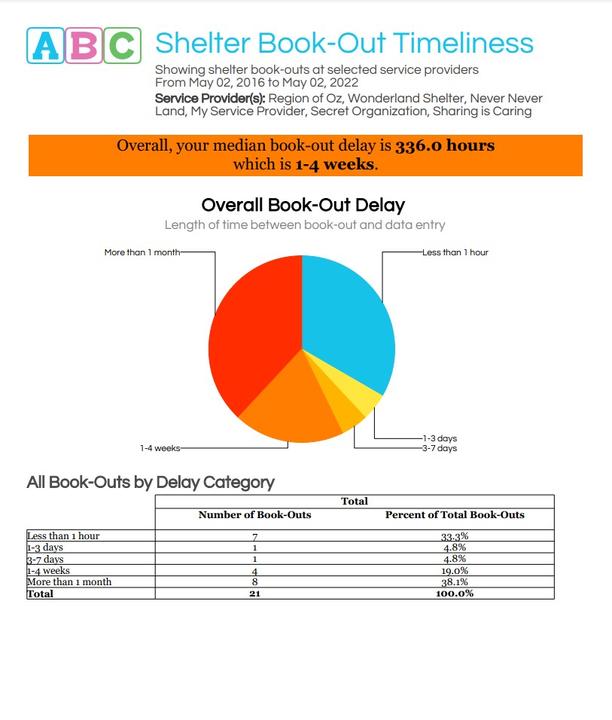
This report contains everything a community or service provider needs to conduct a data quality timeliness audit for their shelter book-outs. It measures the gap between actual book-out time and data entry time.
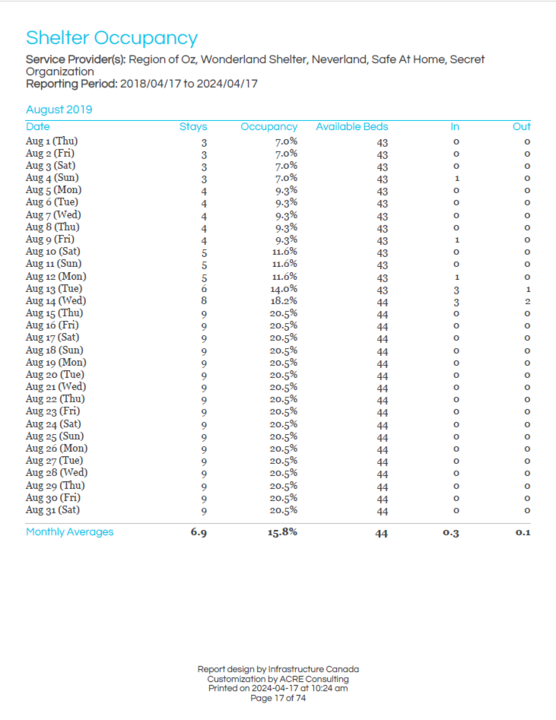
This report shows, for each day in the report range, the number of book ins and book outs and stays.
Note: this is a fixed version of the official HIFIS report.
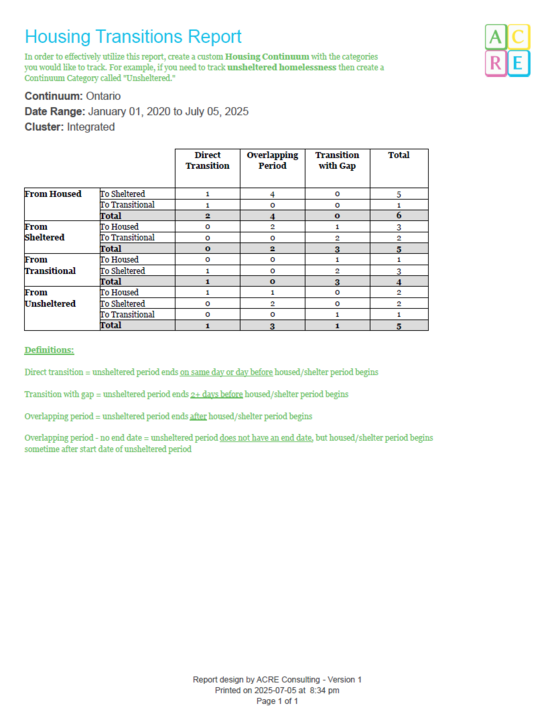
This report identifies and calculates housing transitions, overriding the Housing Status field in HIFIS and looking directly at Housing History and shelter Admissions. Housing transitions are defined as moving from one category in a Housing Continuum to another. If you wish to utilize custom housing categories, add a custom Housing Continuum, which you will be prompted to select when you run the report.
In part, this report is designed to assist Ontario communities required to report on transitions out of unsheltered homelessness.
This report identifies and calculates housing transitions, overriding the Housing Status field in HIFIS and looking directly at Housing History and shelter Admissions. Housing transitions are defined …
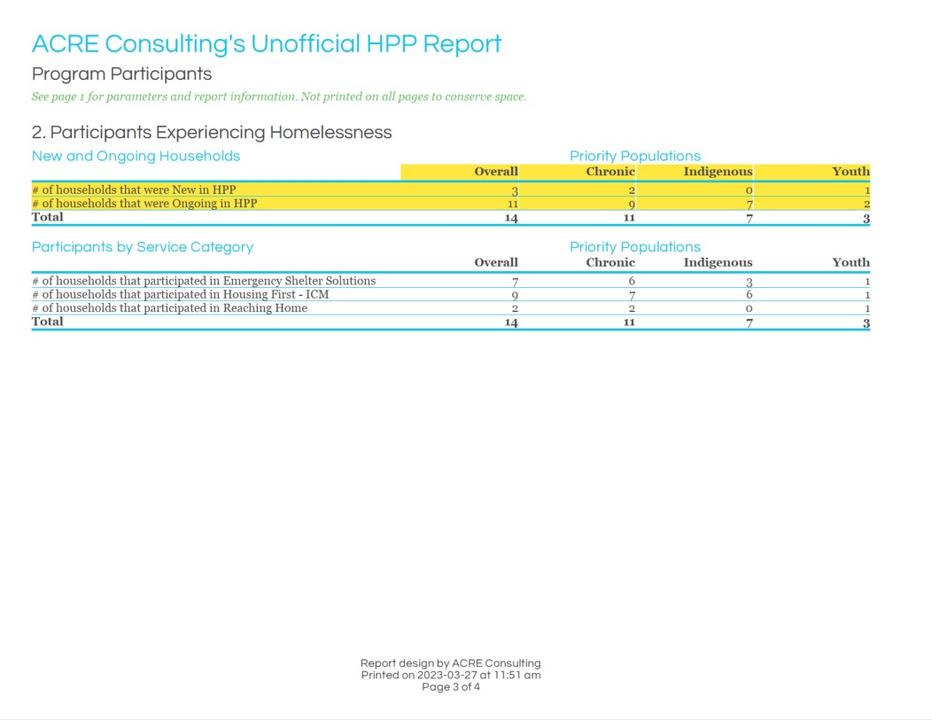
This report is intended to allow communities in Ontario who receive HPP funding to use HIFIS data to report out on the program participants section of the HPP reporting requirements, which encompass the majority of sections 1 and 2. Broadly speaking, the report summarizes data about which households received services associated with which Programs. It also determines the first time the household received a service like it, and from that determines whether the client was homeless or at risk of homelessness at the time, and also whether that means the client was new to HPP or a returning household.
This is an unofficial report and is not endorsed by the Ontario MMAH.
This report is intended to allow communities in Ontario who receive HPP funding to use HIFIS data to report out on the program participants section of the HPP reporting requirements, which encompass t…
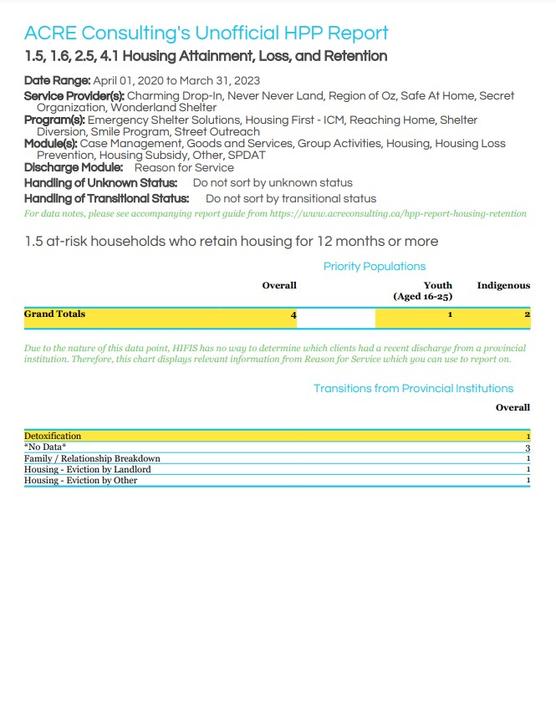
This report is intended to allow communities in Ontario who receive HPP funding to use HIFIS data to report on housing attainment, loss, and retention. Broadly speaking, the report summarizes data about households that had a move-in or retained housing for 12 months or who became homeless, filtered by date range, service providers, programs, and service types.
This is an unofficial report and is not endorsed by the Ontario MMAH.
This report is intended to allow communities in Ontario who receive HPP funding to use HIFIS data to report on housing attainment, loss, and retention. Broadly speaking, the report summarizes data abo…
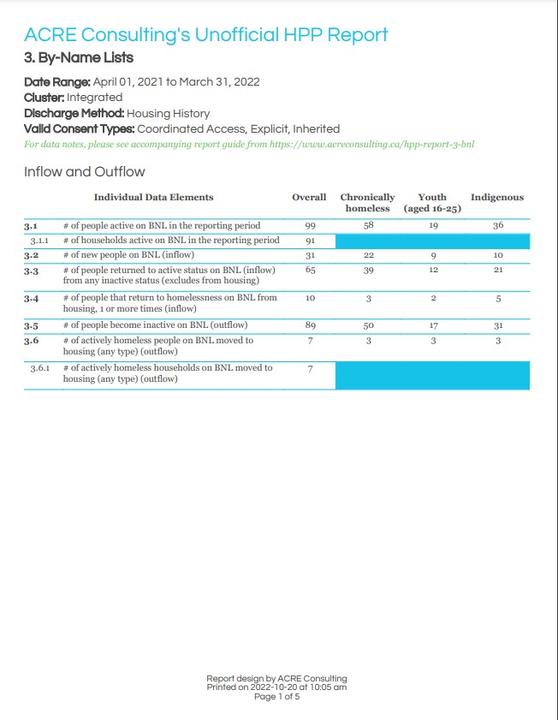
This report is intended to allow Ontario communities who receive HPP funding to use HIFIS data to report out on the By-Name List section of the HPP reporting requirements. Broadly, it reports on the aggregated inflow and outflow to and from your By-Name List (BNL) and breaks down these numbers into the priority population groups.
This is an unofficial report and is not endorsed by the Ontario MMAH.
This report is intended to allow Ontario communities who receive HPP funding to use HIFIS data to report out on the By-Name List section of the HPP reporting requirements. Broadly, it reports on the a…
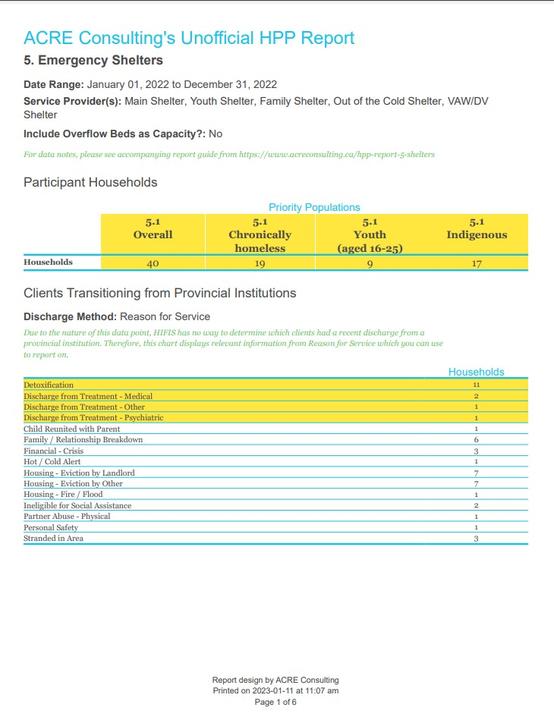
This report is intended to allow communities in Ontario who receive HPP funding to use HIFIS data to report out on the Emergency Shelters section of the HPP reporting requirements. Broadly, it reports on emergency shelter capacity and usage, broken down into priority population groups.
This is an unofficial report and is not endorsed by the Ontario MMAH.
This report is intended to allow communities in Ontario who receive HPP funding to use HIFIS data to report out on the Emergency Shelters section of the HPP reporting requirements. Broadly, it reports…
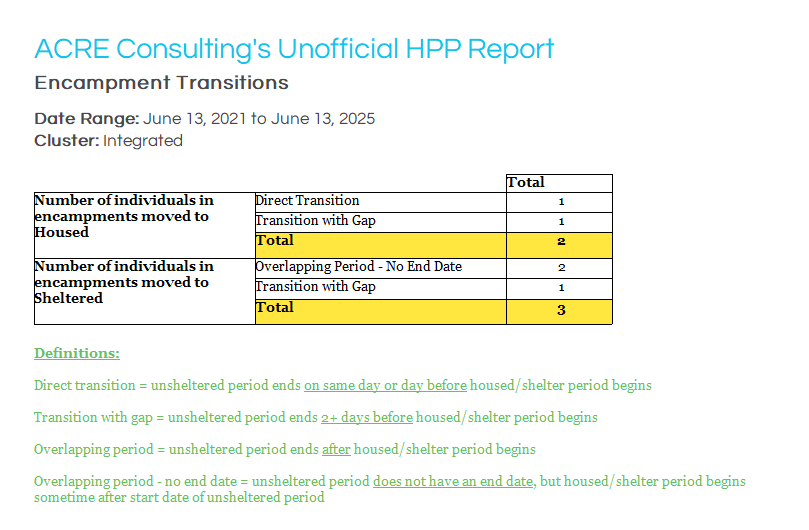
This report is intended to allow communities in Ontario who receive HPP funding to use HIFIS data to report on encampment transitions. This report shows the number of clients who moved from encampments to other housing types.
This is an unofficial report and is not endorsed by the Ontario MMAH.
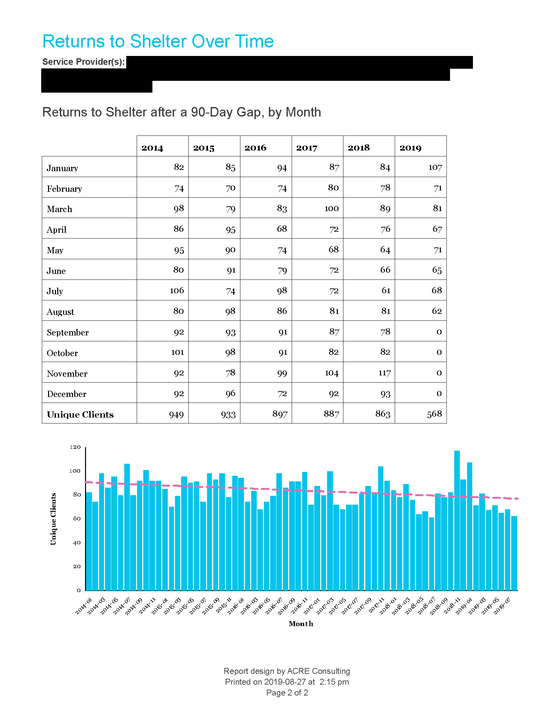
This report aggregates data from the shelter stays of returning clients in HIFIS 4. In other words, when a client has previously stayed in a shelter, then after a period of at least 90 days not in shelter, has a new shelter intake, the date of their new shelter intake is counted. Then it summarizes the total number of returning shelter clients by month and by year, allowing you to track long-term shelter inflow data.
This report aggregates data from the shelter stays of returning clients in HIFIS 4. In other words, when a client has previously stayed in a shelter, then after a period of at least 90 days not in she…
Looking for more?

